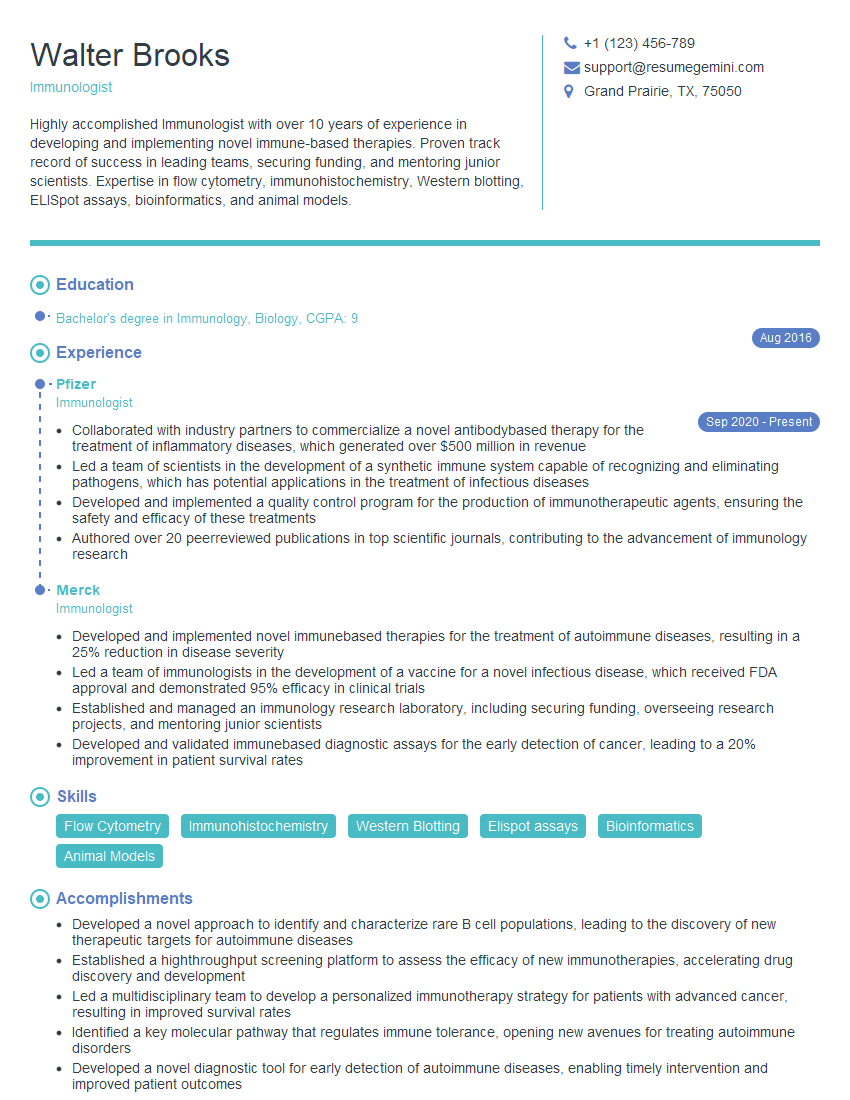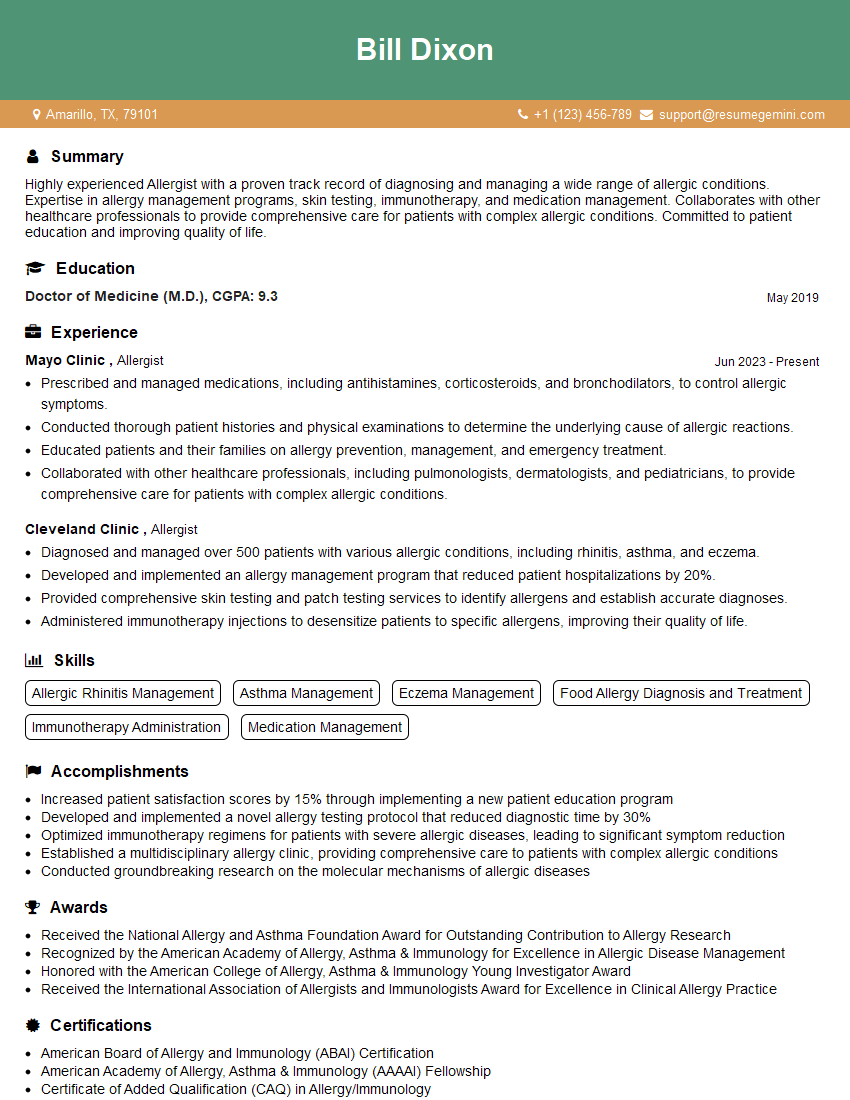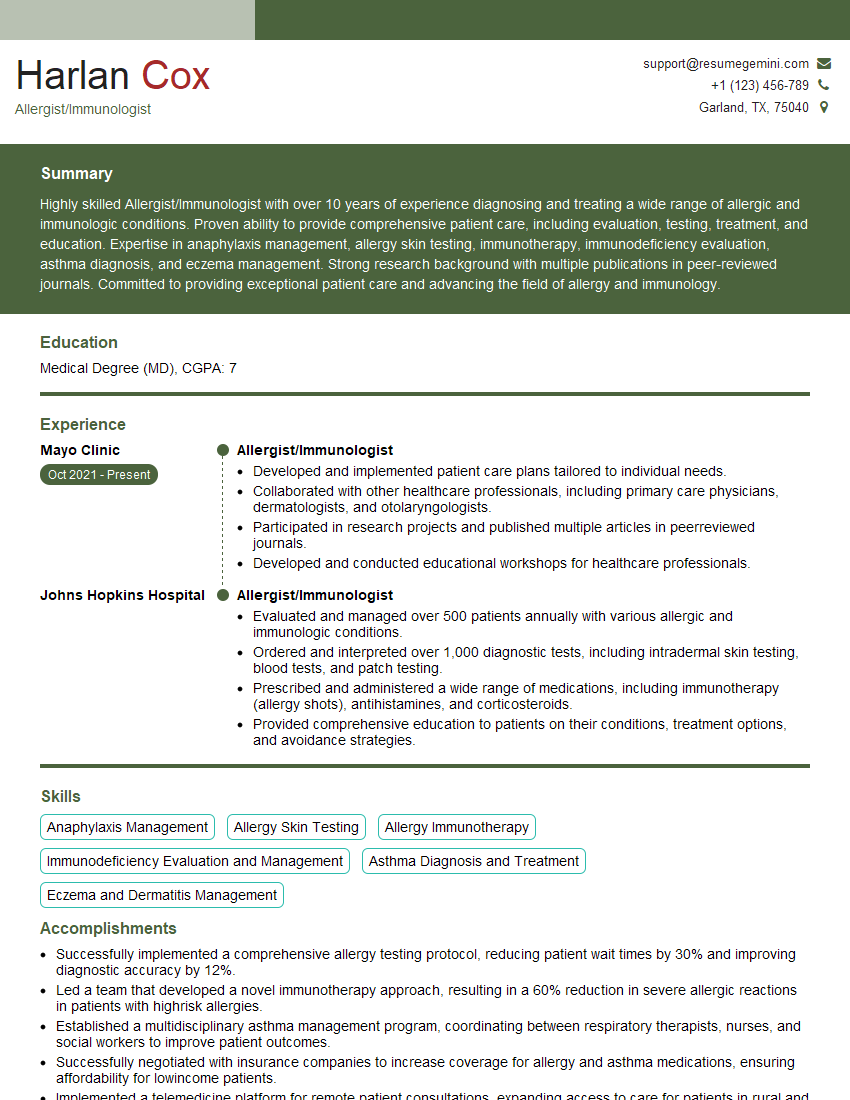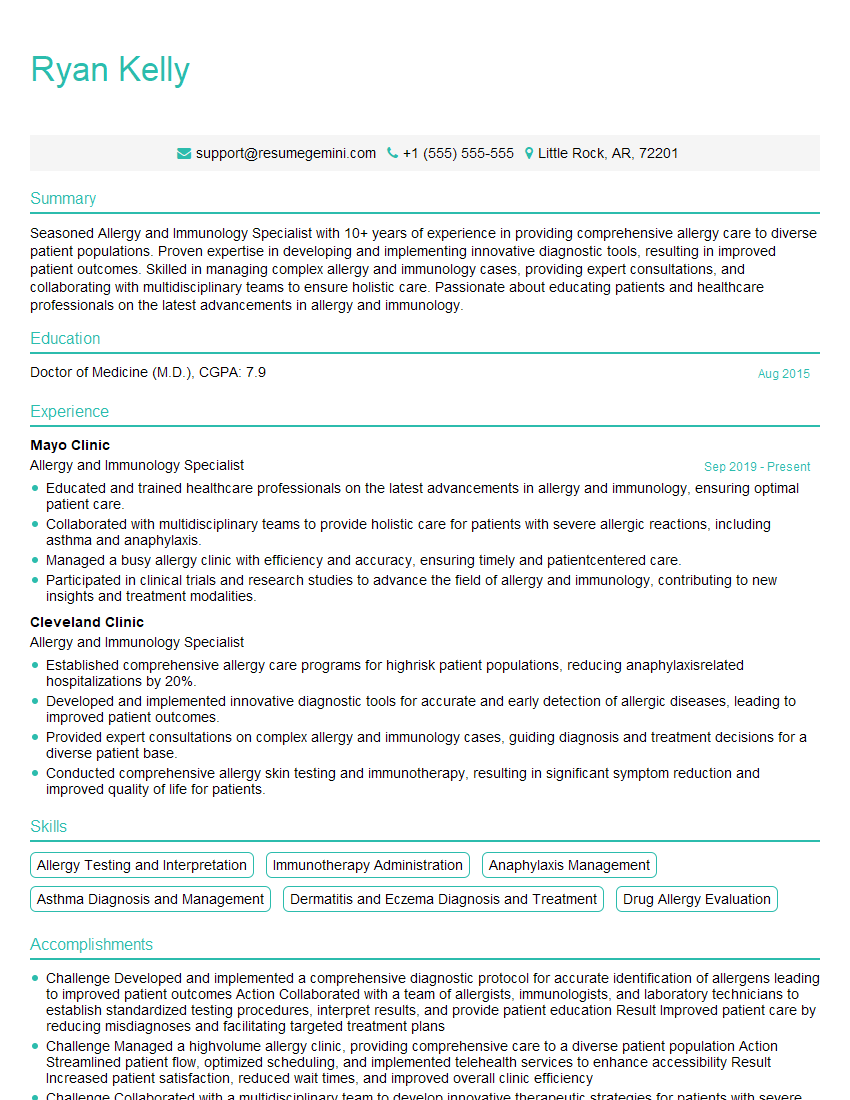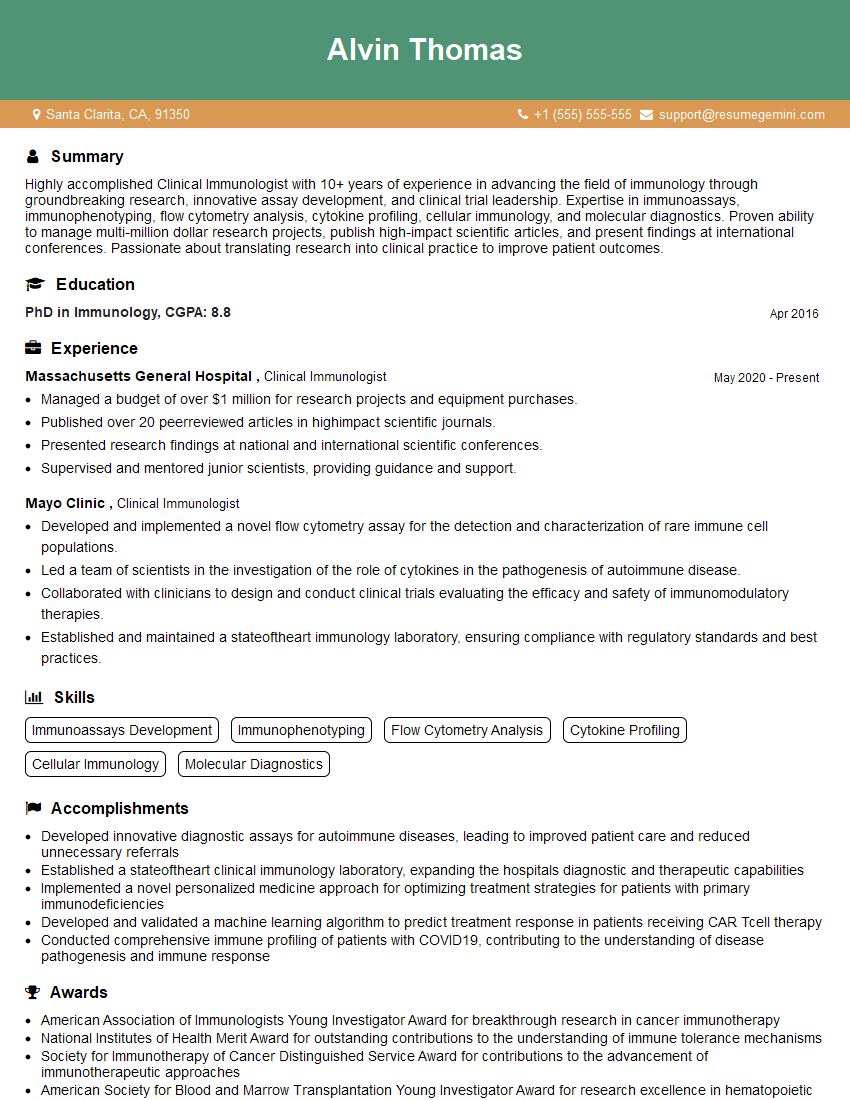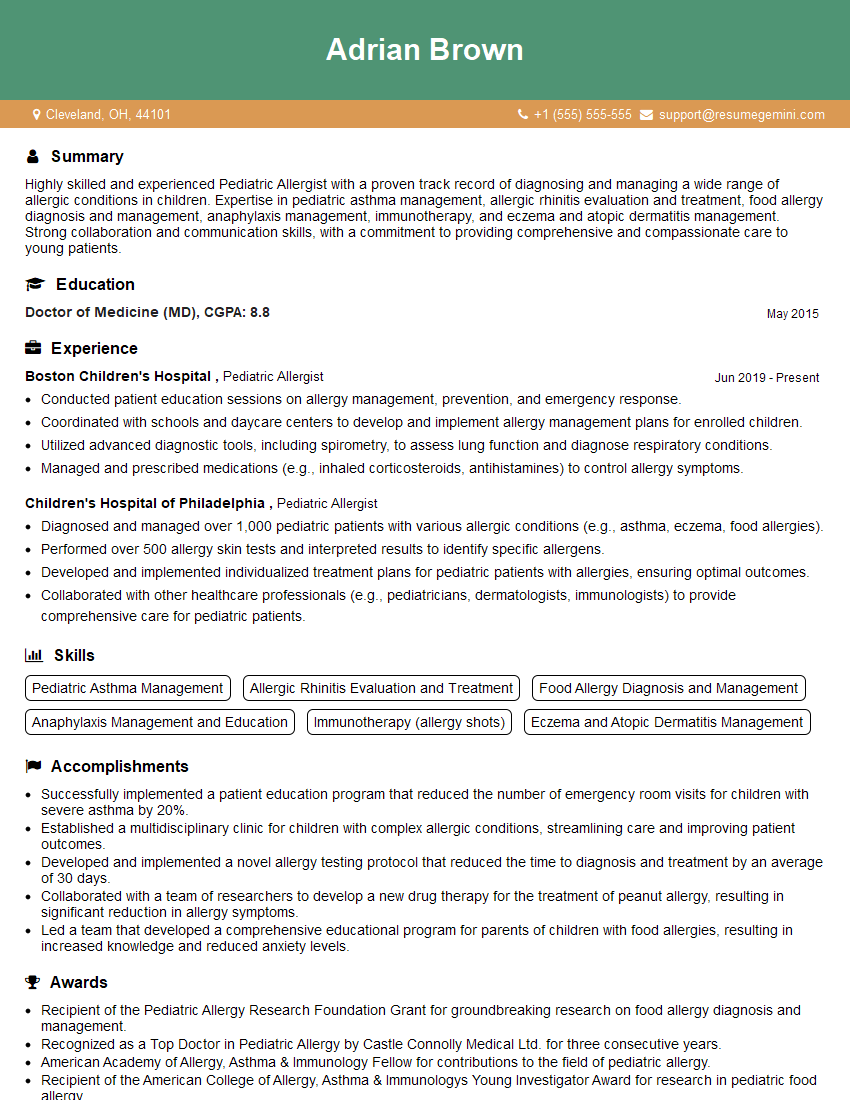Interviews are opportunities to demonstrate your expertise, and this guide is here to help you shine. Explore the essential Adolescent Allergy Management interview questions that employers frequently ask, paired with strategies for crafting responses that set you apart from the competition.
Questions Asked in Adolescent Allergy Management Interview
Q 1. Describe your experience managing food allergies in adolescents.
Managing food allergies in adolescents requires a multifaceted approach combining careful diagnosis, meticulous avoidance strategies, and prompt management of allergic reactions. It’s crucial to remember that teenagers are navigating increased independence, making adherence to dietary restrictions challenging.
My approach begins with a thorough history, including detailed food diaries and documentation of any past reactions. Skin prick testing and/or blood tests (specific IgE) help confirm specific food allergies. We then collaboratively develop an individualized avoidance plan, emphasizing reading food labels carefully and understanding potential cross-contamination risks in restaurants or social settings. This often involves educating the adolescent and their family on how to safely manage food allergies at school, with friends, and during social events. We also discuss emergency preparedness, including carrying epinephrine auto-injectors (like EpiPens) and knowing how to use them. A key component of successful management is empowering the adolescent to take control of their allergy management. For example, I work with them to create a personalized food allergy plan that includes an emergency action plan for use in school or other environments. Finally, I would always recommend regular follow-up appointments to monitor allergy severity and adjust management strategies as needed.
For instance, I recently worked with a 16-year-old with a severe peanut allergy. We collaborated to develop a plan that included an emergency plan for school which was signed by the school nurse, ensuring that teachers knew what to do if an accidental exposure occurred. We also had detailed conversations about reading food labels, understanding potential cross-contamination in food preparation, and assertiveness training so she felt empowered to discuss her allergy with friends and at social gatherings.
Q 2. Explain the diagnostic process for allergic rhinitis in teenagers.
Diagnosing allergic rhinitis in teenagers involves a combination of a detailed medical history, physical examination, and potentially allergy testing. The history should focus on symptoms such as sneezing, runny nose, itchy eyes and nose, and nasal congestion, particularly their relationship to specific triggers like pollen, pets, or dust mites.
A physical exam will look for signs of inflammation in the nose and eyes. Allergy testing typically involves skin prick testing, which involves placing a small amount of allergen extract on the skin and pricking it to see if a reaction occurs. Blood tests (measuring specific IgE antibodies) can be used as an alternative or if skin testing isn’t possible. A positive skin prick test or elevated IgE levels specific to an allergen are strongly suggestive of allergic rhinitis. It’s crucial to differentiate allergic rhinitis from other causes of nasal symptoms, like infections or non-allergic rhinitis, through a comprehensive evaluation.
For example, if a teenager presents with seasonal symptoms such as itchy eyes and runny nose worsening during specific pollen seasons, we’d perform skin prick tests for relevant pollens (such as ragweed, grasses, or trees) to pinpoint the triggers and guide appropriate management.
Q 3. How do you counsel adolescents on the proper use of inhalers?
Counseling adolescents on inhaler use requires clear, patient instruction and demonstration. It’s vital to involve them actively in the process and ensure they understand the ‘why’ behind each step. Many teens feel self-conscious using inhalers, so building confidence and empowering them to self-manage is essential.
My approach begins by explaining the purpose of the inhaler in simple terms, relating it to their asthma symptoms. I then demonstrate proper technique, emphasizing the correct steps: shaking the inhaler, proper breathing, holding their breath, and rinsing their mouth after use (to prevent thrush). I typically use a spacer for better drug delivery, especially in younger teens who might struggle with coordination. I encourage practice sessions and provide written instructions with diagrams. Follow-up visits are scheduled to check inhaler technique and ensure they’re using it effectively.
For example, I explain to a teenager with an asthma inhaler that the medicine within helps open up their airways to ease their breathing, and I show them how to correctly use the inhaler and spacer to get the maximum benefit and minimal side effects. I also encourage them to take their inhaler as prescribed, even when they are feeling well, to prevent future attacks.
Q 4. What are the common challenges in managing asthma in adolescents?
Managing asthma in adolescents presents unique challenges. Adherence to medication regimens often suffers due to social pressures, peer influence, and the adolescent’s desire for independence. They may be less likely to report symptoms or take their medication consistently, leading to poor asthma control and increased risk of exacerbations. Growth spurts can also impact asthma control, necessitating adjustments to medication dosages. Furthermore, adolescents may experience increased stress, anxiety, and depression, factors that significantly trigger or worsen asthma symptoms.
Addressing these challenges involves open communication, collaborative goal setting, and empowering the adolescent to take ownership of their asthma management. Involving parents or caregivers appropriately, while respecting the adolescent’s autonomy, is also critical. Education about triggers, self-monitoring techniques, and early recognition of worsening symptoms is vital. We also explore strategies to manage stress and anxiety, such as mindfulness or relaxation techniques.
For example, I might work with a teenager to design a personalized asthma action plan that includes a schedule for peak flow monitoring, a clear understanding of what constitutes a worsening of their asthma, when to call the doctor and emergency instructions. The plan also includes identifying and minimizing their individual triggers. Finally, we will talk through techniques such as relaxation, mindfulness, and stress reduction strategies if emotional triggers are present.
Q 5. How do you differentiate between allergic and non-allergic rhinitis?
Differentiating between allergic and non-allergic rhinitis relies heavily on a detailed history and often requires excluding other causes. Allergic rhinitis is triggered by specific allergens (e.g., pollen, pets, dust mites), resulting in IgE-mediated inflammation. Symptoms typically include itching of the eyes, nose, and palate, alongside sneezing and a clear, watery nasal discharge.
Non-allergic rhinitis, on the other hand, lacks a specific IgE-mediated allergic mechanism. Causes include viral infections, hormonal changes, irritants (e.g., smoke, perfume), and structural abnormalities within the nasal passages. Symptoms are often less intense and may include more nasal congestion or post-nasal drip than itching.
Allergy testing (skin prick or blood tests) is crucial to confirm allergic rhinitis. In contrast, non-allergic rhinitis is often diagnosed by excluding allergic triggers and other potential causes based on the clinical history and physical examination. Sometimes, nasal endoscopy may be used to identify any anatomical issues.
For example, a teenager with year-round nasal congestion and post-nasal drip, but without itchy eyes or sneezing, might have non-allergic rhinitis. Whereas a teenager with seasonal sneezing, itchy eyes and nose, and a clear discharge that only occurs during specific pollen seasons, would likely have allergic rhinitis.
Q 6. What are the latest advancements in the treatment of allergic conjunctivitis?
Recent advancements in allergic conjunctivitis treatment focus on improving efficacy and minimizing side effects.
- Novel antihistamines: Newer-generation antihistamines, such as olopatadine and ketotifen, offer improved efficacy and fewer sedative side effects compared to older generations.
- Mast cell stabilizers: These medications, such as cromolyn sodium and nedocromil, prevent mast cell degranulation, reducing inflammation. They are particularly helpful for preventing allergic reactions.
- Immunomodulatory therapies: Omalizumab (Xolair) is a monoclonal antibody that targets IgE, reducing the body’s allergic response. It’s particularly useful in moderate to severe cases not controlled by other treatments.
- Combination therapies: Using a combination of antihistamines and mast cell stabilizers often provides better symptom control.
- Artificial tears: Using preservative-free artificial tears can help soothe irritated eyes and improve symptoms.
The choice of treatment depends on the severity of symptoms and the patient’s preferences. For example, a mild case of allergic conjunctivitis might be effectively managed with simple artificial tears and an antihistamine eye drop. More severe cases may require a combination of medications or immunomodulatory therapy.
Q 7. Discuss the management of anaphylaxis in an adolescent setting.
Managing anaphylaxis in adolescents requires immediate action and a structured approach. Anaphylaxis is a severe, life-threatening allergic reaction requiring prompt recognition and treatment.
The first step involves immediate administration of epinephrine via an auto-injector (like an EpiPen). This should be done promptly, even before confirming the diagnosis, as delays can be fatal. After epinephrine administration, the adolescent should be transported to the nearest emergency room immediately. Additional supportive measures may include oxygen administration, airway management (if necessary), intravenous fluids, and monitoring vital signs.
Education is key. Adolescents should be trained to recognize early symptoms of anaphylaxis (e.g., hives, swelling, difficulty breathing, dizziness) and know how to self-administer epinephrine. Families and school personnel should also be educated about anaphylaxis recognition and management. A comprehensive anaphylaxis action plan detailing emergency steps and contact information is essential for schools and other relevant environments. Regular follow-up with an allergist is crucial for adjusting medication and monitoring potential triggers.
For example, in my practice, I educate adolescents and their families on the importance of prompt epinephrine administration. I demonstrate the correct injection technique using a training device. We create personalized anaphylaxis action plans that are shared with school nurses and coaches. After anaphylaxis, we meticulously review the events, discuss any potential triggers, and assess whether adjustments are necessary in the patient’s allergy management.
Q 8. How do you address concerns about the long-term effects of allergy medications?
Addressing concerns about the long-term effects of allergy medications requires a nuanced approach, balancing the immediate benefits of symptom control with potential long-term risks. For example, while antihistamines are generally safe for long-term use, some adolescents might experience drowsiness or other side effects. Similarly, nasal corticosteroids, while effective for allergic rhinitis, might have rare side effects like nasal dryness or epistaxis (nosebleeds) with prolonged use.
My strategy involves a thorough discussion with the adolescent and their family. We weigh the benefits of continued medication against the potential risks, considering the severity of the allergy, the impact on their quality of life, and the adolescent’s individual response to the medication. We regularly monitor for side effects and adjust the treatment plan accordingly. In some cases, we might explore alternative treatment strategies, such as immunotherapy, to reduce reliance on long-term medication. Transparency and open communication are key to addressing these concerns effectively.
For instance, if an adolescent is experiencing persistent drowsiness from an antihistamine, we might explore switching to a non-sedating antihistamine or reducing the dosage. We always prioritize patient safety and well-being, ensuring informed consent at every stage of treatment.
Q 9. Explain the role of immunotherapy in adolescent allergy management.
Immunotherapy, also known as allergy shots or sublingual immunotherapy (SLIT), plays a crucial role in modifying the underlying allergic response in adolescents. Unlike medication that simply manages symptoms, immunotherapy aims to desensitize the immune system to the allergen, offering long-term relief. It works by gradually introducing increasing doses of the allergen, helping the body to build tolerance.
In adolescents, immunotherapy is particularly beneficial for those with moderate to severe allergic rhinitis, asthma triggered by allergens, or insect sting allergies. The decision to initiate immunotherapy involves careful consideration of the adolescent’s age, allergy severity, overall health, and commitment to the treatment regimen, which typically involves regular injections or sublingual tablets over several years. The potential benefits of long-term relief often outweigh the small risks associated with immunotherapy.
For example, an adolescent with severe pollen allergy leading to frequent asthma attacks could significantly benefit from immunotherapy, potentially reducing their reliance on rescue inhalers and improving their quality of life. We carefully monitor for any adverse reactions during immunotherapy sessions.
Q 10. Describe your approach to educating adolescents and their families about allergy management.
Educating adolescents and their families is paramount in effective allergy management. My approach is multifaceted and tailored to the individual’s age, understanding, and learning style. It involves clear, simple explanations of their allergies, the mechanisms involved, and the rationale behind treatment options. I utilize visual aids, such as diagrams and charts, and incorporate interactive elements to improve engagement.
For younger adolescents, I involve parents extensively, ensuring they understand the management plan and can support their child’s adherence. As adolescents mature, I gradually shift the focus towards empowering them to manage their own allergies, teaching them self-management skills like medication administration, recognizing allergy triggers, and using emergency action plans.
I emphasize the importance of consistent medication use, avoidance strategies, and emergency preparedness. I also encourage open communication and answer their questions honestly and patiently. For example, I might role-play scenarios to help them practice using their inhaler or epinephrine auto-injector. This individualized, collaborative approach promotes long-term success and empowers adolescents to take control of their health.
Q 11. How do you manage adolescents with complex, multi-system allergies?
Managing adolescents with complex, multi-system allergies requires a highly coordinated and specialized approach. These adolescents might have multiple food allergies, respiratory allergies, and other sensitivities, making symptom management challenging. A multidisciplinary team, potentially including allergists, immunologists, pulmonologists, gastroenterologists, and mental health professionals, is crucial.
My approach involves meticulously documenting the adolescent’s allergy history, conducting comprehensive allergy testing to identify triggers, and developing a detailed management plan that addresses all aspects of their allergies. This includes strategies for avoiding triggers, managing acute reactions, and preventing future episodes. Emergency preparedness is vital, ensuring the adolescent and family are equipped to handle severe reactions. We frequently collaborate with other specialists to provide holistic care.
For example, an adolescent with multiple food allergies, asthma, and eczema requires careful dietary management, asthma control medications, and topical treatments for eczema. Regular monitoring and adjustments to the treatment plan based on the adolescent’s response are essential in these complex cases.
Q 12. Discuss your experience with allergy testing in adolescents.
Allergy testing in adolescents involves a combination of skin prick tests and blood tests. Skin prick tests are generally preferred for their speed and cost-effectiveness, identifying immediate hypersensitivity reactions to allergens. Blood tests (such as specific IgE antibody tests) are used to detect specific allergies, especially in cases where skin prick tests are unreliable or contraindicated.
I always explain the procedure clearly to the adolescent and their family, emphasizing the importance of accurate results and the potential for mild discomfort during skin prick testing. The testing process is tailored to the adolescent’s individual needs and suspected allergens, and results are carefully interpreted and discussed to create a personalized management plan.
We might start with a comprehensive panel of common allergens and then tailor the testing further based on the adolescent’s history and initial results. For example, if an adolescent reports seasonal allergy symptoms, we might conduct testing for common airborne allergens. If they experience reactions after eating certain foods, we’d test for those specific foods.
Q 13. What are the common psychological challenges faced by adolescents with allergies?
Adolescents with allergies can face several psychological challenges. The constant need for vigilance and the potential for unexpected reactions can lead to anxiety and fear. Social limitations due to dietary restrictions or environmental avoidance measures can contribute to feelings of isolation and depression. Body image issues can arise from the use of topical medications or the visible effects of allergies, such as eczema.
I address these challenges by creating a safe and supportive environment where adolescents feel comfortable expressing their concerns. I involve the adolescent in decision-making about their care and empower them to manage their condition effectively. I also collaborate with mental health professionals when necessary, providing referrals for counseling or therapy to support their emotional well-being. Education and peer support groups can also be very beneficial, helping adolescents connect with others who understand their experiences.
For instance, an adolescent with severe food allergies might feel anxious about attending social events or eating out. We work together to develop strategies for navigating these situations safely, such as carrying emergency medication, communicating their needs to hosts and restaurant staff, and practicing relaxation techniques to manage anxiety.
Q 14. How do you manage medication adherence in adolescent patients?
Medication adherence is a significant challenge in managing adolescent allergies. Adolescents may forget to take medications, be reluctant to carry inhalers or epinephrine auto-injectors, or resist medication side effects. My approach focuses on collaboration and communication, involving the adolescent in developing a medication schedule that fits their lifestyle. We use visual aids, such as pill organizers or medication reminder apps, and encourage family support to enhance adherence.
Open communication is key. I address any concerns or questions the adolescent may have about their medications and actively involve them in decision-making. We discuss potential side effects and develop strategies for managing them. I also monitor their medication use closely and provide regular reinforcement and support. If challenges persist, we explore collaborative strategies such as motivational interviewing and work with the adolescent and family to create a tailored adherence plan.
For example, if an adolescent is struggling to remember to take their daily antihistamine, we might explore using a pill organizer or setting medication reminders on their phone. If they dislike the taste of a liquid medication, we might explore alternative formulations.
Q 15. What are the key considerations when prescribing medication to adolescents with allergies?
Prescribing medication for adolescents with allergies requires careful consideration of several factors. We must balance efficacy with safety and consider the adolescent’s developmental stage, potential side effects, adherence, and the specific allergy in question.
- Developmental Stage: Adolescents are still developing, and certain medications might have different effects compared to adults. For example, the dosage of some antihistamines needs adjustment based on weight and age. We also need to consider their understanding of the medication and their ability to self-administer it safely.
- Side Effects: Some allergy medications, such as antihistamines, can cause drowsiness, which might affect school performance or driving ability. We discuss these potential side effects with the adolescent and their parents to make an informed decision. We might explore non-drowsy options if drowsiness is a concern.
- Adherence: Adolescents may struggle with medication adherence. We need to work with them to develop a plan that is easy to follow, and we may involve parents or guardians to ensure compliance. Using a pill organizer or setting reminders can be helpful.
- Specific Allergy: The type of allergy dictates the medication choice. For seasonal allergies, we might prescribe antihistamines or intranasal corticosteroids. For food allergies, the focus is on avoidance and emergency preparedness (e.g., epinephrine auto-injectors).
For instance, a teenager with severe seasonal allergies might benefit from a combination of a long-acting antihistamine and a nasal steroid spray. We carefully monitor their response and adjust the treatment as needed. Open communication is key to ensure the medication regimen is effective and manageable.
Career Expert Tips:
- Ace those interviews! Prepare effectively by reviewing the Top 50 Most Common Interview Questions on ResumeGemini.
- Navigate your job search with confidence! Explore a wide range of Career Tips on ResumeGemini. Learn about common challenges and recommendations to overcome them.
- Craft the perfect resume! Master the Art of Resume Writing with ResumeGemini’s guide. Showcase your unique qualifications and achievements effectively.
- Don’t miss out on holiday savings! Build your dream resume with ResumeGemini’s ATS optimized templates.
Q 16. How do you address the potential for drug interactions with allergy medications?
Drug interactions are a significant concern when managing allergies, especially as adolescents often take multiple medications for various conditions. We thoroughly review the patient’s medication history and any potential interactions. This involves checking medication databases and consulting with other healthcare professionals when necessary.
- Common Interactions: Certain antihistamines can interact with other medications, including some antidepressants and sedatives. We carefully consider these possibilities and make appropriate adjustments to the medication regimen.
- Herbal Supplements and OTC Medications: We also inquire about any use of herbal supplements or over-the-counter (OTC) medications as these too can interact with allergy medications. Many people don’t consider these products to be ‘medications’, however, they are often powerful enough to impact a prescribed medicine.
- Documentation: Detailed documentation of all medications, including OTC drugs and supplements, is essential to prevent potential drug interactions. We maintain clear records in the patient’s chart and communicate effectively with other healthcare providers involved in their care.
For example, if an adolescent is taking an MAOI (monoamine oxidase inhibitor) antidepressant, certain antihistamines could lead to potentially serious interactions. We would either choose a different antihistamine or work closely with the prescribing psychiatrist to find a safe and effective treatment plan.
Q 17. Describe your experience with managing severe allergic reactions.
Managing severe allergic reactions, like anaphylaxis, requires swift and decisive action. My experience involves immediate recognition of the signs and symptoms (e.g., difficulty breathing, swelling, hives), prompt administration of epinephrine (via an EpiPen or Auvi-Q), and activation of emergency medical services (EMS).
- Epinephrine Administration: Training patients and their families on proper epinephrine auto-injector use is paramount. We provide hands-on training and ensure they understand the importance of administering the injection immediately upon recognizing symptoms of anaphylaxis.
- EMS Activation: Even after epinephrine administration, immediate EMS intervention is crucial. Epinephrine provides temporary relief; subsequent medical attention is needed for monitoring and ongoing treatment in the hospital.
- Post-Reaction Care: Following a severe allergic reaction, we work with the patient and their family to develop a comprehensive action plan. This includes follow-up appointments with allergy specialists, review and update of allergy plans, potential allergy testing, and education on avoiding the allergen.
I recall a case where a teenager experienced anaphylaxis after accidental peanut exposure. Prompt administration of epinephrine and immediate EMS intervention were crucial in preventing a fatal outcome. The subsequent allergy testing and development of a comprehensive action plan, including carrying two epinephrine auto-injectors, significantly reduced the risk of future occurrences.
Q 18. How do you use technology (e.g., apps, wearables) to improve allergy management?
Technology plays an increasingly important role in improving allergy management in adolescents. We utilize various apps and wearables to enhance communication, monitoring, and adherence.
- Allergy Tracking Apps: These apps allow patients to track exposure to allergens, symptoms, medication usage, and even environmental factors (pollen counts). This data provides valuable insights into triggers and treatment effectiveness.
- Wearable Sensors: Devices like smartwatches can monitor vital signs (heart rate, respiratory rate) which can be helpful in detecting early signs of an allergic reaction. This provides an additional layer of monitoring, especially for adolescents who might not always verbalize their symptoms.
- Telemedicine: Telemedicine platforms allow for remote consultations and monitoring. This is particularly beneficial for adolescents in remote areas or those with busy schedules. We can provide support, adjust medications, and address concerns remotely, enhancing convenience and adherence.
For example, an adolescent using an allergy tracking app could identify a correlation between their asthma symptoms and exposure to specific pollen types. This information allows us to refine their treatment plan, potentially adding a controller medication or adjusting the timing of their current treatments to better address their triggers.
Q 19. Explain your approach to patient education on self-management of allergies.
Patient education is central to successful allergy management. My approach involves a multi-faceted strategy that uses various methods to ensure the adolescent understands their condition and how to manage it.
- Age-Appropriate Information: I use clear and concise language tailored to the adolescent’s understanding and developmental stage, avoiding medical jargon whenever possible.
- Interactive Sessions: We engage in interactive sessions, including role-playing and demonstrations (such as using an EpiPen), ensuring practical skills are mastered.
- Written Materials: Supplementing verbal explanations with written materials, including medication instructions, allergy action plans, and emergency procedures is crucial. We ensure that the patient and their family receive and understand these materials.
- Parental Involvement: Parental involvement is essential, particularly for younger adolescents. We ensure that parents understand the condition and treatment plan to offer support and supervision.
For instance, when educating a teenager about food allergies, I use a combination of detailed explanations, visual aids, and interactive sessions to ensure they understand how to avoid their allergens, read food labels correctly, and manage accidental exposures. The combination of multiple strategies helps improve comprehension and retention.
Q 20. Discuss your knowledge of current guidelines for the diagnosis and treatment of food allergies.
Current guidelines for diagnosing and treating food allergies emphasize a thorough history, skin prick testing, and serum-specific IgE testing. Diagnosis should be made by a qualified allergist or immunologist. Treatment involves strict allergen avoidance, emergency preparedness (epinephrine auto-injectors), and in some cases, immunotherapy (oral immunotherapy or sublingual immunotherapy).
- Diagnosis: A detailed history helps pinpoint potential food allergens. Skin prick testing is a quick and relatively low-cost method to assess immediate hypersensitivity to common allergens. Serum-specific IgE testing measures the level of IgE antibodies specific to certain allergens, providing further confirmation of allergy.
- Treatment: The cornerstone of food allergy management is strict avoidance of the offending allergen. This includes careful reading of food labels, understanding potential cross-contamination, and educating family, friends, and school personnel. Epinephrine auto-injectors are essential for managing severe reactions.
- Immunotherapy: For some patients, especially those with well-controlled mild allergies, immunotherapy may be considered. However, it should only be initiated and monitored by trained allergists due to potential risks.
For example, if a child has a history of hives and vomiting after eating peanuts, skin prick and serum-specific IgE testing would be employed to confirm the diagnosis of peanut allergy. Treatment would focus on strict peanut avoidance, education about cross-contamination, and carrying an epinephrine auto-injector.
Q 21. How do you handle cases of suspected allergic reactions in a school setting?
Suspected allergic reactions in a school setting require prompt and decisive action. My approach involves collaboration with school nurses, teachers, and parents to ensure the adolescent’s safety.
- School Allergy Action Plan: A comprehensive allergy action plan, developed in consultation with the allergist, should be in place and readily available to school personnel. This plan outlines the symptoms of an allergic reaction, the steps to take in case of a reaction, including medication administration (if applicable), and procedures for contacting emergency services.
- Staff Training: School staff, including nurses and teachers, should receive training on recognizing the signs of allergic reactions and administering emergency medications (if delegated by a physician). Regular training sessions and drills reinforce proper procedures.
- Communication: Open communication between the allergist, parents, school nurse, and teachers is vital to ensure consistent allergy management. Any changes in the child’s condition or treatment should be promptly communicated to all relevant parties.
For example, if a student experiences hives and difficulty breathing at school, the school nurse should immediately follow the pre-determined allergy action plan, administer emergency medication (if permitted and appropriate), contact the parents, and call for emergency medical services if necessary. Post-incident review helps identify areas for improvement and ensures the plan’s effectiveness.
Q 22. How do you incorporate shared decision-making into your treatment plans for adolescents?
Shared decision-making is paramount in adolescent allergy management. It’s not just about telling a teenager what to do; it’s about empowering them to actively participate in their care. This approach fosters adherence and ownership of their health. I begin by providing clear, age-appropriate explanations of their allergies, potential triggers, and treatment options. We then discuss the pros and cons of each approach, considering their lifestyle, preferences, and potential risks. For example, if a teen with pollen allergies is considering a medication versus immunotherapy, we’ll discuss the efficacy, side effects, and long-term implications of each. I encourage them to ask questions and express concerns. The ultimate treatment plan is a collaborative effort, ensuring the teenager feels heard and understood, leading to better compliance.
I use tools like decision aids and visual aids to help illustrate complex concepts. It’s about building a therapeutic alliance where the adolescent feels in control of their health journey.
Q 23. What is your experience with collaborating with other healthcare professionals (e.g., dietitians, psychologists)?
Collaboration is essential in adolescent allergy management. I frequently work with registered dietitians, especially when managing food allergies. They provide tailored dietary advice and help navigate the complexities of food labeling and safe food preparation. Psychologists are invaluable in addressing the emotional and psychological impact of allergies, particularly the anxiety and social implications that can arise, especially around food allergies or severe reactions. For instance, a dietitian can help an adolescent with a peanut allergy create a safe and enjoyable meal plan, while a psychologist can help them navigate social situations where food is involved. This multidisciplinary approach ensures holistic care and tackles both the medical and psychosocial aspects of allergies.
Q 24. Describe your approach to risk assessment and management in adolescent allergy patients.
Risk assessment is a continuous process, starting with a thorough history and physical examination. For example, we assess the severity of their allergic reactions—from mild symptoms like hives to life-threatening anaphylaxis. We identify potential triggers, quantify exposure risks (e.g., frequency of exposure to allergens), and determine the patient’s understanding of their allergy and self-management skills. For adolescents with food allergies, we assess their ability to read labels, avoid cross-contamination, and carry and administer their epinephrine auto-injectors. For insect sting allergies, we discuss strategies to avoid stings and the need for carrying an epinephrine auto-injector. Risk management involves developing a personalized action plan, including emergency preparedness (e.g., carrying epinephrine), avoidance strategies, and medication management. Regular follow-up appointments allow for ongoing monitoring and adjustments to the management plan.
Q 25. How do you handle challenging patient-family dynamics in allergy management?
Challenging patient-family dynamics are not uncommon. I address these by creating a safe space for open communication. I facilitate family meetings where each member can express their concerns and perspectives. It’s important to recognize that each family member might have different levels of understanding and comfort with the diagnosis and management plan. For instance, a parent may be overly anxious, while the adolescent may feel frustrated by the limitations imposed by their allergies. I employ active listening and empathy to navigate these tensions. I also ensure that the adolescent’s voice is heard and respected. Providing education to both the adolescent and the family is key, ensuring everyone is on the same page about the treatment plan and emergency protocols. When necessary, I refer families to support groups or additional counseling.
Q 26. Discuss your experience with managing specific types of adolescent allergies (e.g., insect stings, latex allergies).
Managing specific allergies in adolescents requires a tailored approach. For insect sting allergies, I emphasize avoidance strategies, such as wearing protective clothing during outdoor activities, and ensuring the availability and proper use of epinephrine auto-injectors. I provide detailed training on self-administration and emphasize the importance of seeking immediate medical attention after a sting. Latex allergies often require careful attention to environmental controls—avoiding latex-containing products in school and work settings. I work closely with schools and other environments to ensure safe environments for the adolescent. For food allergies, I collaborate with a registered dietitian to create personalized meal plans that accommodate the adolescent’s dietary needs and preferences, while always emphasizing safe food handling practices and emergency preparedness.
Q 27. How do you stay up-to-date with the latest research and advancements in adolescent allergy management?
Staying current in adolescent allergy management is crucial. I regularly attend continuing medical education courses and conferences focused on allergy and immunology. I actively participate in professional organizations like the American Academy of Allergy, Asthma & Immunology (AAAAI). I regularly review peer-reviewed journals such as the Journal of Allergy and Clinical Immunology, keeping abreast of the latest research findings and treatment guidelines. I also utilize online resources and clinical practice guidelines provided by reputable organizations. This commitment to continuous learning ensures that my patients receive the most up-to-date and effective care.
Q 28. Describe a case where your problem-solving skills were crucial in managing a complex adolescent allergy case.
I once had a 15-year-old patient who experienced severe anaphylaxis after accidentally ingesting peanuts. While he carried an epinephrine auto-injector, he hadn’t been trained properly on its use. Following the incident, I not only provided comprehensive training to him and his family but also identified a gap in his understanding of food allergy management. I employed a multi-pronged approach: we worked with a dietitian to develop a thorough avoidance plan, a psychologist addressed his anxiety about future exposures, and we collaborated with his school to establish safety protocols. This combined approach, which used my problem-solving skills to address the immediate emergency and the underlying issues, significantly improved his management and alleviated his anxiety. The case highlighted the importance of individualized care and collaboration amongst specialists to provide holistic management of adolescent allergies.
Key Topics to Learn for Adolescent Allergy Management Interview
- Physiological Differences in Adolescent Allergy Responses: Understanding how the adolescent immune system differs from that of children and adults, impacting diagnosis and treatment.
- Common Adolescent Allergies & Triggers: In-depth knowledge of prevalent allergens (e.g., pollen, food, medications) and their presentation in adolescents. Practical application: Differentiating between allergic reactions and other conditions.
- Psychosocial Aspects of Allergy Management in Adolescents: Addressing the emotional and social challenges faced by adolescents with allergies, including adherence to treatment plans and coping mechanisms.
- Pharmacotherapy in Adolescent Allergy Management: Understanding the appropriate use and limitations of various medications (e.g., antihistamines, corticosteroids, immunotherapy) in adolescents, including considerations for growth and development.
- Allergy Testing & Diagnostic Procedures in Adolescents: Proficiency in interpreting allergy test results and selecting appropriate diagnostic methods based on the patient’s age and specific needs.
- Anaphylaxis Management and Prevention in Adolescents: Comprehensive knowledge of anaphylaxis recognition, emergency treatment (including epinephrine administration), and development of personalized prevention strategies.
- Adolescent-Specific Communication & Patient Education: Techniques for effectively communicating with adolescents and their families about allergy management, emphasizing shared decision-making and empowering self-management.
- Asthma Co-morbidity and Management: Understanding the high prevalence of asthma in adolescents with allergies and effective strategies for managing both conditions concurrently.
- Food Allergy Management in Adolescents: Strategies for navigating social situations, navigating dining out, and managing accidental exposures. This includes understanding the legal implications of food labeling and allergen avoidance in schools and other settings.
- Emerging Trends & Research in Adolescent Allergy Management: Staying current with advancements in diagnosis, treatment, and research related to adolescent allergies.
Next Steps
Mastering Adolescent Allergy Management significantly enhances your career prospects, opening doors to specialized roles and leadership opportunities within the field. A well-crafted, ATS-friendly resume is crucial for showcasing your skills and experience to potential employers. To maximize your job search success, we strongly encourage you to utilize ResumeGemini, a trusted resource for building professional and impactful resumes. ResumeGemini provides examples of resumes tailored specifically to Adolescent Allergy Management, helping you present your qualifications effectively and stand out from the competition.
Explore more articles
Users Rating of Our Blogs
Share Your Experience
We value your feedback! Please rate our content and share your thoughts (optional).
What Readers Say About Our Blog
This was kind of a unique content I found around the specialized skills. Very helpful questions and good detailed answers.
Very Helpful blog, thank you Interviewgemini team.
